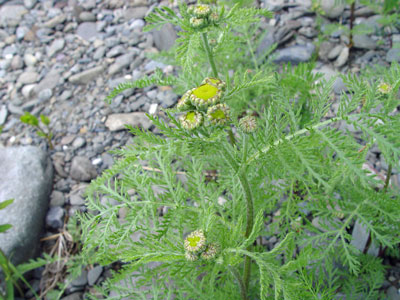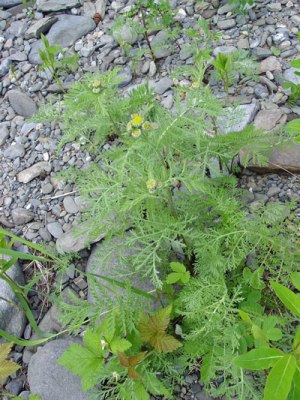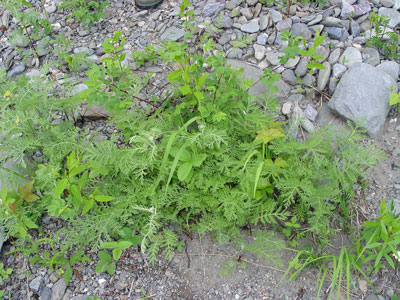DACF Home → Bureaus & Programs → Maine Natural Areas Program → Communities, Plants, and Animals → Rare Plants → Tanacetum bipinnatum

Tanacetum bipinnatum (L.) Schultz-Bip. ssp. huronense (Nutt.) Breitung
Huron Tansy
- State Rank: S2S3
- Global Rank: G5T4T5
- State Status: Special Concern
Habitat: Gravelly or cobbly, ice-scoured beaches of large rivers. [Non-tidal rivershore (non-forested, seasonally wet)]
Range:St. John, Aroostook, and Restigouche River systems in Maine, Quebec, and New Brunswick; other varieties of the species occur west through Canada.
Aids to Identification: Huron tansy is a very low, sprawling plant with broad, finely dissected leaves. The leaves are a pale greyish green and are strongly aromatic. The flower heads resemble those of the common tansy, i.e., they are button-like and yellow, but they are much larger, up to 1-2 cm across. Unlike the common tansy, Huron tansy usually has small ray flowers. This plant is easily recognized by its habit, habitat, and finely cut, aromatic leaves.

Ecological characteristics: Tanacetum bipinnatum ssp. huronense grows in a specific and periodically disturbed habitat: cobbly river beaches which are scoured and flooded yearly by ice and water moving down the rivers. The plant has long, creeping rootstocks and spreads clonally into broad mats. Not all of the plants flower every year. Huron tansy usually grows with other riverbeach species such as Prunus pumila var. depressa, Astragalus alpinus var. brunetianus, and Allium schoenoprasum.
Phenology: An herbaceous perennial, flowering in mid-June in Maine.
Family: Asteraceae
Synonyms: Chrysanthemum bipinnatum L. ssp. huronense (Nutt.) Hultén; Tanacetum huronense Nutt.; Tanacetum huronense Nutt. var. johannense Fern.

Known Distribution in Maine: This rare plant has been documented from a total of 11 town(s) in the following county(ies): Aroostook.
Reason(s) for rarity: Restricted habitat.
Conservation considerations: Maintain hydrologic integrity of its rivershore habitat, including the natural disturbance by water and ice. Populations could be harmed if all-terrain vehicle use of the habitat increases.